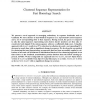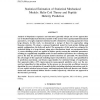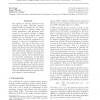114
Voted
JCB
2007
15 years 21 days ago
2007
Accurate prediction of pseudoknotted nucleic acid secondary structure is an important computational challenge. Prediction algorithms based on dynamic programming aim to find a st...
85
Voted
JCB
2007
15 years 21 days ago
2007
We present a novel approach to managing redundancy in sequence databanks such as GenBank. We store clusters of near-identical sequences as a representative union-sequence and a se...
130
Voted
JCB
2007
15 years 21 days ago
2007
Many bioinformatics problems can implicitly depend on estimating large-scale covariance matrix. The traditional approaches tend to give rise to high variance and low accuracy esti...
JCB
2007
15 years 21 days ago
2007
Analysis of biopolymer sequences and structures generally adopts one of two approaches: use of detailed biophysical theoretical models of the system with experimentally-determined...
92
Voted
JCB
2007
15 years 21 days ago
2007
In this paper, we study the problem of computing the similarity of two protein structures ring their contact-map overlap. Contact-map overlap abstracts the problem of computing th...
92
Voted
JCB
2007
15 years 21 days ago
2007
Long-range correlations in genomic base composition are a ubiquitous statistical feature among many eukaryotic genomes. In this article, these correlations are shown to substantia...
133
Voted
JCB
2007
15 years 21 days ago
2007
The problem of inferring haplotypes from genotypes of single nucleotide polymorphisms (SNPs) is essential for the understanding of genetic variation within and among populations, ...
101
Voted
JCB
2007
15 years 21 days ago
2007
Locality is an important and well-studied notion in comparative analysis of biological sequences. Similarly, taking into account affine gap penalties when calculating biological ...



